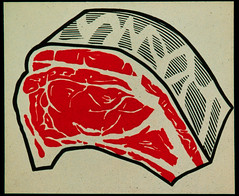Because of the Spanish cookbooks I had gotten earlier in the week, I was in the mood for Spanish influenced food and maybe some Spanish wine. If you’re cooking meat and you’re cooking Spanish food, chances are you’re cooking pork. Of course, they cook all kinds of meat in Spain, but pork seems to hold a revered place sort of the same way it does in Chinese cuisine. I still had some thick cut loin chops from a whole pork loin I had bought, so I decided to use a couple of those but cut them in half to make four thin cutlets. I had been thinking a lot about the chicken in sherry sauce from my tapas menu early in the week and decided it was time for pork and piquillo peppers in a garlic sherry sauce. It was a weeknight (even if it was Friday), so I was looking for something pretty straightforward and easy and this would fit the bill. I still had some white beans salad left over from the previous evening, so that was one less thing to have to make. To bulk it all out, I opted to roast some peeled red potatoes with olive oil, salt, pepper and thyme (easy and truly satisfying if you let them go long enough to get really crisp outside and really creamy inside). I was thinking that some aioli would be nice with the potatoes, but I realized I probably didn’t want to get that involved, although the suggestion that a lot of people make of using commercial mayonnaise with some garlic, did have some appeal, even though I normally eschew such things.
I sautéed the cutlets in a pan with olive oil, took them out, added four cloves of chopped garlic and a pinch of sweet pimenton (smoked Spanish paprika, not be confused with normal paprika) and let that all cook for about 30 seconds before deglazing the pan with amontillado sherry. I added several julienned piquillo peppers and some parsley and let it all reduce. Then I put the cutlets back in and flipped them to coat them with the sauce. Then I served them up with the cold white beans and hot roasted potatoes.
I’m a huge fan of Spanish wine, and like many wine people I keep waiting for when Spain will finally become the “next big thing.” Spanish wine is tremendously undervalued even though many prices have doubled in the last ten to fifteen years. I’m not talking about the multi-hundred dollar bottles of wines from Priorat but the $10-20 bottles. There are great $5 to $10 bottles as well. Many are made from Garnacha, which is what Grenache is called in Spain. Many Spanish wines are aged at the winery for several years before release and most are ready to go when released although many of these will get better with age. Tonight’s wine was a bottle of 1995 Condada de Haza from the Ribera del Duero. Condada de Haza is made by Alejandro Fernandez of Pesquera fame, but contrary to many beliefs, it’s not the second label of Pesquera but a new property with younger vines. Fernandez’s wines have always been top notch, and considerably cheaper than those of his neighbor, the esteemed Vega Sicilia.
In all fairness, it’s probably safe to say that 1995 Condado de Haza was never really meant to be a long lived wine, because the vines are younger than Pesquera and as a result shouldn’t have the same concentration of flavor. When I poured it into the glass, I was amazed how dark and purple it still was. There was a little band of brick-red at the rim, but this wasn’t didn’t look like a wine that was way past its prime. I had tried a 1996 several months ago that hadn’t aged as well. The nose was filled with black cherries, vanilla, dark berries, a slight spice note, and the tar scents that you expect from this region. The vanilla notes form the oak aging were well integrated with the fruit and played along with it but didn’t overshadow the rich deep fruit. There was a little bit of alcohol warmth in the finish, but the wine was balanced and had a long finish.
Unsurprisingly, the food and wine went well together. This was due mainly to fact that the food and wine seemed to have an affinity for each other because they shared a common cultural heritage. Pork doesn’t normally seem to require such a big rich red, but when paired with the roasted piquillo peppers, the smoky pimenton, the garlic and the deep flavors of the amontillado, it seemed to demand a rich full red. It was also well suited to a single slice of Manchego cheese that I had as dessert. I normally prefer beer with great cheese, but the rich nuttiness of the cheese and the deep tarry fruit of the wine were a great counterpoint. Not bad for a simple Friday night dinner.
The wine was better than I had expected, and although maybe past its peak by a couple years, was quit remarkable (this bottle had been stored at temperature controlled conditions since its release). In an age when too many wines are drunk too young, it’s nice to drink a wine that’s been carefully aged. Even after a couple of hours of being open it didn’t start to show the oxidized flavors of a wine that was way past its peak. If I had more I would drink it up soon, but if you had more I would gladly cook you a good Spanish influenced dinner if you’d share it with me.
Friday, July 20, 2007
Pork cutlets and Condado de Haza
Posted by
Bill
at
8:05 PM
![]()
![]()
Labels: condado de haza, pesquera, pimenton, ribera del duero, spansih food
Subscribe to:
Post Comments (Atom)

No comments:
Post a Comment